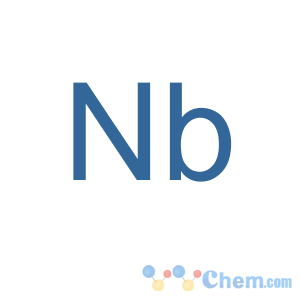Title: Niobium
CAS Registry Number: 7440-03-1
Synonyms: Columbium
Literature References: Nb; at. wt 92.90638; at. no. 41; valence 2, 3, 4, 5; usually pentavalent. Group VB (5). One naturally occurring isotope: 93Nb; artificial, radioactive isotopes: 88-92; 94-101. Approximately as abundant as nickel. Occurs in nature together with tantalum in the minerals
columbite [(Fe,Mn)(Nb,Ta)2O6],
pyrochlore (NaCaNb2O6F) and
tantalite [(Fe,Mn)(Ta,Nb)2O6]. Discovered by Hatchett in 1801, isolated by Blomstrand in 1866, named after Niobe, daughter of Tantalos. Extracted from columbite which is mined largely in Nigeria and Zaire. Less than 10% of niobium-bearing ores come from the US, Canada, and Norway. Reviews of niobium and its compds:
Technology of Columbium (Niobium) B. W. Gonser, E. M. Sherwood, Eds. (Wiley, New York, 1958); G. L. Miller,
Tantalum and Niobium (Academic Press, New York, 1959) 767 pp; Brown, "The Chemistry of Niobium and Tantalum" in
Comprehensive Inorganic Chemistry Vol. 3, J. C. Bailar, Jr.
et al., Eds. (Pergamon Press, Oxford, 1973) pp 553-622; P. H. Payton in
Kirk-Othmer Encyclopedia of Chemical Technology vol. 15 (Wiley-Interscience, New York, 3rd ed., 1981) pp 820-840.
Properties: Steel-gray, lustrous metal. Ductile and malleable when pure. Lattice structure: body-centered cube, lattice constant: 3.294 ?. d 8.57. mp 2468°. bp 4927°. Sp ht: 6.012 cal/g-atom/°C. Heat of sublimation: 170.9 kcal/g-atom; heat of combustion: 2379 cal/g. Coefficient of linear expansion per °C: 7.1 ′ 10-6. Electrical resistivity (20°): 13.2 mohm-cm. Temp coefficient of electrical resistivity per °C: 0.00395. Electron work function: 4.01 ev. Ionization potential: 6.77 V. Inert toward HCl, HNO3 or aqua regia, but attacked by fusion with akali hydroxides or oxidizing agents.
Melting point: mp 2468°
Boiling point: bp 4927°
Density: d 8.57
Use: In ferrous metallurgy: Ferroniobium (produced by silicon reduction of columbite) is used to alloy stainless steels and metals for welding rods. In niobium base alloys for high temps and nuclear reactions. Niobium has some use as a getter in electronic vacuum tubes.

